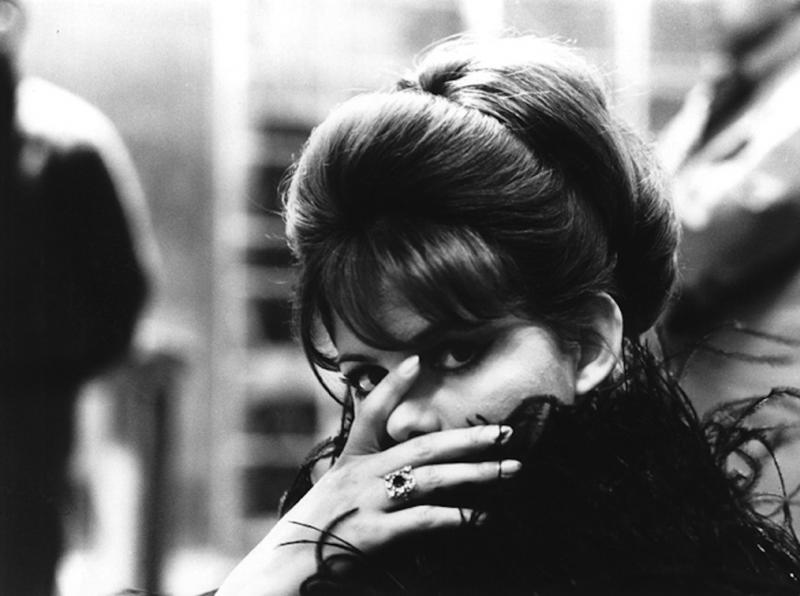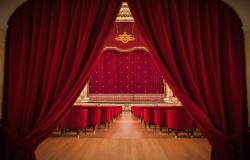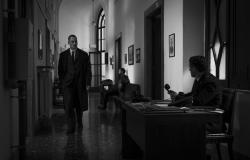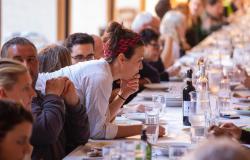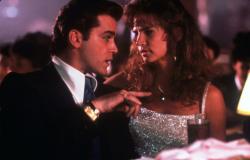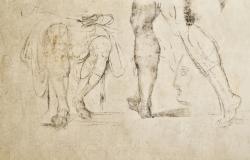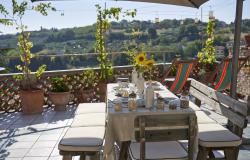When I met Claudia Cardinale, it took me a while to realise who I was really looking at or talking to. The venue was Locarno Film Festival, Switzerland, where Cardinale received a Golden Leopard for her lifetime achievement in August 2011. There I was, dazed, listening to the husky voice of the legendary Italian actress, not to mention one of the most beautiful women to appear on movie screens anywhere, trying to focus on what she was saying. My mind was full of flashbacks from all sorts of films I’d watched her in, adjectives like captivating, gorgeous and admirable accompanied the images I had parading before me.
As one of Fellini’s best known films, 8 1/2, had just been screened as homage to her and the famous director, it seemed appropriate to ask her what it was like to work with Fellini (d.1993) and Marcello Mastroianni(d.1996) cast for the lead role doing the alter ego of Fellini himself going through a crisis, Cardinale plays his inspirational muse.
“I only did one film with Fellini but he made me feel the centre of the Earth, the most beautiful, the most important. I truly miss him, his sweetness, tenderness, his thin voice even. Acting for him was like an event, there was no script, the set was noisy, it was chaotic, anarchy reigned, yet he was able to isolate himself and get on with the job, you thought you were doing everything spontaneously, any which way was you pleased, but at the end of the day you’d done exactly what he had in mind. Marcello was a sociable, happy person, and loved acting, the only person he took seriously on set was the director. He was charming, everybody liked him, he was the quintessential Latin lover.”
Fellini’s 8 1/2 and Luchino Visconti’s costume drama, Gattopardo (The Leopard), a big-budget production set in 19th-century Sicily where Cardinale starred alongside Burt Lancaster and Alain Delon, were shot at about the same time. Both movies truly launched the 24-year-old actress’ career in early 1960s. “It was hard doing both,” she remembered, “Visconti wanted me dark-haired, for Fellini I had to be a blonde, I had long hair at the time and kept dying it from one to the other. The two directors were completely different, almost hated each other, I think, Visconti was a perfectionist, on set nobody could say a word unless instructed. Working for these two directors in these two films marked a turning point in my career.”

How would Cardinale describe herself? As a teenager I was wild, a bit crazy, a tomboy, I got into fistfights with boys just to show them girls can be stronger than them. I have always accepted challenges. When I was young, I remember catching the train after it had pulled out, I used to run and jump on even though I was on the platform, perfectly in time for the departure, just to show I could do it. This attitude also helped me on set when I found myself the only woman surrounded by men, I wasn’t intimidated, I felt able to compete with them. My philosophy of life has always been: If you want, you can. You can’t be weak if you want to do this job, I have never even re-married [after her divorce from Franco Cristaldi in 1975] just to keep myself completely independent. Having said that, I don’t want people to judge me for the choices I’ve made in my personal life but judge me for my work.”
1938-born actress also had a few words in support of graceful ageing. “You can’t stop time. I’ve never had anything done to my face, I hate the idea of a facelift. I think the secret of keeping youthful is remaining very active, never surrendering.”
Yet, Cardinale’s film career began with reluctance. She was born in the port town of La Goulette, Tunisia, some 10 km from the capital Tunis, to second generation of Sicilian parents. At the time Tunisia was a French protectorate and Cardinale’s mother tongue became French; till around the age of 18 she couldn’t even speak Italian. At an Italian film event in Tunis she was elected, The Most Beautiful Italian in Tunisia. “I hadn’t even entered the contest,” Cardinale recalls, “I was picked out of the crowd and by force accompanied to the stage, a sash was placed over my shoulder and I was declared the winner. The prize was a trip to Venice Film Festival where the first film I saw was, Visconti’s Le Notti Bianche (white nights).” Her cinema career began, reluctantly in a short called Anneaux d'Or (golden ring) by René Vautier screened at Berlin Film Festival, she was filmed together with her school mates, even so it made her a local celebrity. Again without much enthusiasm she was cast to appear in a Tunisian film, Goha, by Jacques Baratier to do a supporting role with Omar Sharif playing the lead role. After her trip to Venice, she was offered the opportunity to study at the Centro Sperimentale Cinematografico in Rome. She was 17 at the time, after three months she’s had enough, acting is not for her, this attitude problem coupled with language difficulties, her Italian is inadequate, she calls it a day and returns to Tunisia only to discover shortly after to be expecting a child from a relationship with a mysterious Frenchman 10 years her senior, she decides to keep the child, a son she called Patrizio. Highly motivated to find a job, she signs a contract with Vides, an Italian film studio ran by Franco Cristaldi, 14 years her senior, who will become her first, and only, husband between 1966 and 1975. After the divorce Cardinale’s life companion became filmmaker Pasquale Squitieri, they had a daughter and, just to keep it in the family, she too was called Claudia.
The budding actress got her first role in a major film in Mario Monicelli’s classic comedy I Soliti Ignoti (The Usual Suspects) made in pure neo-realist style, in 1958. She was co-starring with Marcello Mastroianni and of this popular black and white movie made so long ago she still has fond memories, “It was in a way my film debut. Mario was an extraordinary person, with rare intelligence and memory. At the time I couldn’t understand everything he was saying, with all the gesticulating and shouting I thought they were having arguments all the time. ”
Early on in her career, the mass media depicted her as the olive skinned, dark featured version of Brigitte Bardot everyone called BB, Claudia Cardinale was abbreviated to CC. On the wave of this popularity the two sex symbols co-starred Les Petroleuses (The Legend of Frenchie King) a French parody of a Western made in 1971.
CC was, however, already an international star after appearing in Blake Edwards all-time-hit, The Pink Panther in 1963 co-starring Peter Sellers and David Niven. She recalls, “David Niven was a perfect gentleman every woman would want to be with, he would open doors, walk a step behind you and offer his arm at every opportunity to help you out. Peter Sellers was so much fun to work with, you couldn’t stop laughing, but off the set, he was gloomy, unhappy, he couldn’t enjoy the success he was having.”
To date CC has appeared in around 90 feature films but her most productive decade remains 1960 – 1970 when she clocked up some 30 movies including the classics 8½ (1962-3), The Leopard (1963), and the Westerns, The Professionals (1966) co-starring with Burt Lancaster and Lee Marvin and the cult movie Once Upon a Time In The West (1968) directed by maestro Sergio Leone. What does CC remember about working with Leone? “His method of work was unique. He would have the music composed before the shooting started, he would get us to listen to the score before filming the scene.”
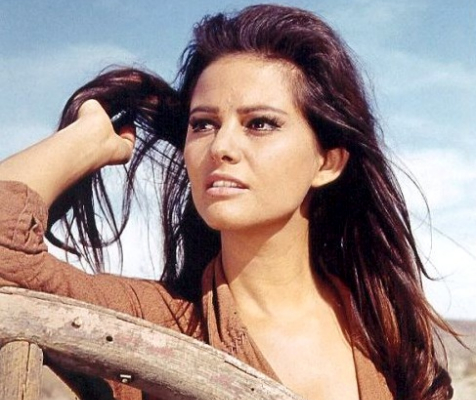
Of her career in USA Cardinale notes, “My main advantage was that I didn’t ask to go to Hollywood, they called me. In those days whenever a new star caught their attention, the Hollywood studios had to have him or her, they tried to monopolise all the stars. They tied you down with a contract and in a way destroyed your career, I tried to defend myself, for instance I refused an exclusive contract with the Universal and only signed one contract at a time and managed to survive.”
Besides The Pink Panther and The Professionals, during her three-year stint in Hollywood CC co-starred with the likes of Rock Hudson in Blindfold, with John Wayne and Rita Hayworth in, Circus World, as well as rubbing shoulders with many stars such as Barbara Streisand, Steve McQueen and Warren Beatty, the notorious playboy, but CC insists, “With Warren I had a nice friendship, absolutely nothing more.”
Her separation from Cristaldi (d.1992) was a major event not only in her personal life, “I finally felt fee of the stereotype of the young actress attached to a producer who dominated, dictated her career. I was now able to work on equal terms.” Yes, but this freedom came with a price, the soured relationship with Cristaldi, who, not only obstructed her career but also Squitieri’s. In 1976, CC was contacted by Franco Zeffirelli to appear in Jesus of Nazareth he was making for TV. It was to be set in Monastir, Tunisia, Cardinale’s country of birth, it almost seemed like a re-birth for CC the international star. After this first work Cardinale has been cast in a dozen other TV movies over the years.
Early 1980s, CC made the headlines for two significant films, La Pelle (1981) directed by Liliana Cavani, where Cardinale teamed up with Marcello Mastroianni, for the 4th time, in a war drama set in Naples in 1944 earning CC the best supporting actress award in Italy. The same year Cardinale was contacted by the German filmmaker Werner Herzog to take part in, Fitzcarraldo, about an Irishman played by Klaus Kinsky who wants to construct the largest opera house anywhere right in the middle of the Amazon, in early 20th century. Cardinale distinctly remembers this unusual movie in an unusual setting, “We worked in extreme conditions, it was unbearably hot, Jason Robards at some point climbed up a tree and demanded a New York steak to come down. Eventually he was replaced by Klaus Kinski. I don’t know how but I survived.” Fitzcarraldo won the Palme d’Or at Cannes 1982.

Starting 1990, CC’s movie appearances gradually decreased but did not stop. Over the next two decades she acted in over a dozen movies but also made an important decision to take on the challenge of theatre acting. She debuted with La Venexiana in 2000, she was 62 at the time. Set in 16th-century Venice, it tells the story of two women dissatisfied with their sentimental lives. Why didn’t Cardinale attempt theatre before? “I didn’t feel up it, I thought my voice was also inappropriate.”
By 2011 CC had received lifetime achievement awards from all major and many lesser film festivals around the world, the latest was at Locarno in August 2011.
The UK daily, Independent, perhaps gave the best summary of Cardinale in an article they published on the 12th of March 2011, listing the Italy’s top 15 cultural exports; number one spot was giving to Claudia Cardinale, “Some might say Loren, some Lollobrigida, some Bellucci, but of all the Italian screen goddesses who dominated post-war western cinema, it was Ms Cardinale who took the Garibaldi. Equally ravishing when tousled (The Professionals), or tightly coiffed (The Leopard), playing bosomy peasant girl (Cartouche), or leggy trapeze artiste (The Magnificent Showman), she glowed, pouted, teased and always looked indefinably, sparkily on-for-it. Her kohl-drenched eyes flashed. Her smile dazzled. ‘If you ask me,’ said David Niven, ‘Claudia Cardinale is, after spaghetti, Italy's happiest invention.’ "
***
You can find below 2 E-books written by Martin Gani:
*) 25 Years in Italy
An informative, insightful and entertaining account of life in contemporary Italy.
*) Celebrities
Celebrities narrates the lives and works of 40 filmmakers, actors and writers the author has met over the last 15 years
